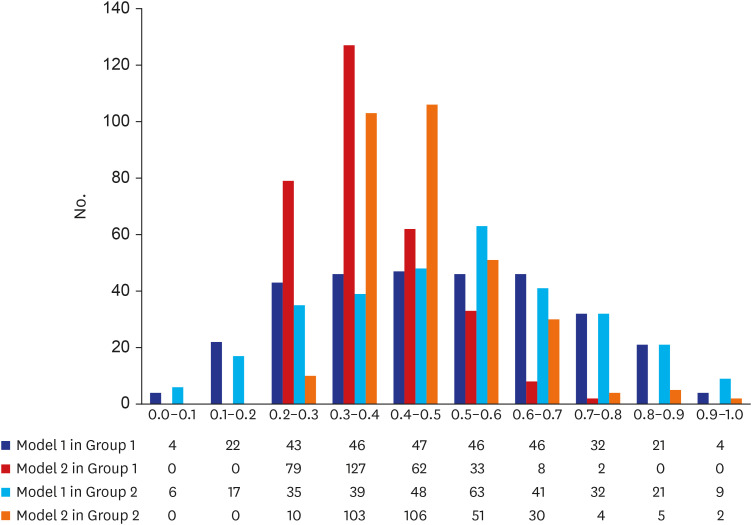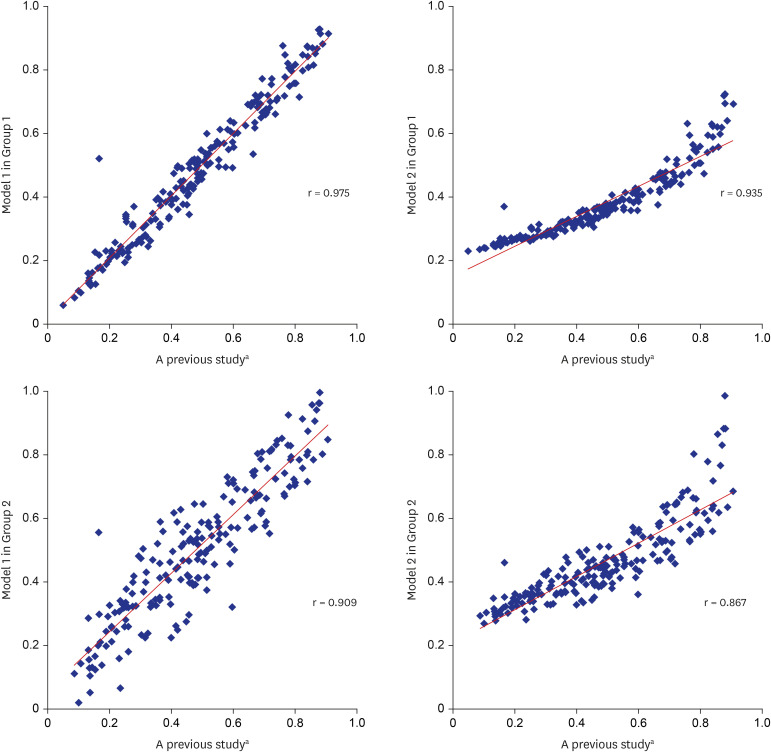J Korean Med Sci.
2020 Jul;35(27):e219. 10.3346/jkms.2020.35.e219.
Updating Disability Weights for Measurement of Healthy Life Expectancy and Disability-adjusted Life Year in Korea
- Affiliations
-
- 1Department of Preventive Medicine, Korea University College of Medicine, Seoul, Korea
- 2Big Data Department, National Health Insurance Service, Wonju, Korea
- 3Department of Preventive Medicine, University of Ulsan College of Medicine, Seoul, Korea
- 4Department of Preventive Medicine, Ewha Womans University College of Medicine, Seoul, Korea
- 5Department of Preventive Medicine, School of Medicine, Kyung Hee University, Seoul, Korea
- 6Department of Preventive Medicine, Ulsan University Hospital, University of Ulsan College of Medicine, Ulsan, Korea
- KMID: 2504263
- DOI: http://doi.org/10.3346/jkms.2020.35.e219
Abstract
- Background
The present study aimed to update the methodology to estimate cause-specific disability weight (DW) for the calculation of disability adjusted life year (DALY) and health-adjusted life expectancy (HALE) based on the opinion of medical professional experts. Furthermore, the study also aimed to compare and assess the size of DW according to two analytical methods and estimate the most valid DW from the perspective of years lost due to disability and HALE estimation.
Methods
A self-administered web-based survey was conducted ranking five causes of disease. A total of 901 participants started the survey and response data of 806 participants were used in the analyses. In the process of rescaling predicted probability to DW on a scale from 0 to 1, two models were used for two groups: Group 1 (physicians and medical students) and Group 2 (nurses and oriental medical doctors). In Model 1, predicted probabilities were rescaled according to the normal distribution of DWs. In Model 2, the natural logarithms of predicted probabilities were rescaled according to the asymmetric distribution of DWs.
Results
We estimated DWs for a total of 313 causes of disease in each model and group. The mean of DWs according to the models in each group was 0.490 (Model 1 in Group 1), 0.378 (Model 2 in Group 1), 0.506 (Model 1 in Group 2), and 0.459 (Model 2 in Group 2), respectively. About two-thirds of the causes of disease had DWs of 0.2 to 0.4 in Model 2 in Group 1. In Group 2, but not in Group 1, there were some cases where the DWs had a reversed order of severity.
Conclusion
We attempted to calculate DWs of 313 causes of disease based on the opinions of various types of medical professionals using the previous analysis methods as well as the revised analysis method. The DWs from this study can be used to accurately estimate DALY and health life expectancy, such as HALE, in the Korean population.
Figure
Cited by 2 articles
-
Trends and Patterns of Cancer Burdens by Region and Income Level in Korea: A National Representative Big Data Analysis
Yoon-Sun Jung, Seok-Jun Yoon
Cancer Res Treat. 2023;55(2):408-418. doi: 10.4143/crt.2022.126.Korean National Burden of Disease: The Importance of Diabetes Management
Chung-Nyun Kim, Yoon-Sun Jung, Young-Eun Kim, Minsu Ock, Seok-Jun Yoon
Diabetes Metab J. 2024;48(4):518-530. doi: 10.4093/dmj.2024.0087.
Reference
-
1. Mundial B. World Development Report 1993; Investing in Health. Oxford: Oxford University Press;1993.2. Murray CJ, Salomon JA, Mathers CD, Lopez AD, Organization WH. Summary Measures of Population Health: Concepts, Ethics, Measurement and Applications. Geneva: World Health Organization;2002.3. Ock M, Lee JY, Oh IH, Park H, Yoon SJ, Jo MW. Disability weights measurement for 228 causes of disease in the Korean Burden of Disease study 2012. J Korean Med Sci. 2016; 31(Suppl 2):S129–38. PMID: 27775250.
Article4. Murray CJ, Lopez AD, Organization WH. The global burden of disease: a comprehensive assessment of mortality and disability from diseases, injuries, and risk factors in 1990 and projected to 2020: summary. Updated 1997. Accessed March 8, 2020. https://apps.who.int/iris/handle/10665/41864.5. Stouthard ME, Essink-Bot M, Bonsel G, Barendregt J, Kramers P, Van de Water H, et al. Disability Weights for Diseases in the Netherlands. Amsterdam: Instituut voor Sociale Geneeskunde;1997.6. Schwarzinger M, Stouthard ME, Burström K, Nord E. Cross-national agreement on disability weights: the European Disability Weights Project. Popul Health Metr. 2003; 1(1):9. PMID: 14633276.
Article7. Jelsma J, Chivaura VG, Mhundwa K, De Weerdt W, de Cock P. The global burden of disease disability weights. Lancet. 2000; 355(9220):2079–2080. PMID: 10885386.
Article8. Haagsma JA, Polinder S, van Beeck EF, Mulder S, Bonsel GJ. Alternative approaches to derive disability weights in injuries: do they make a difference? Qual Life Res. 2009; 18(5):657–665. PMID: 19421894.
Article9. Groce NE. Disability in cross-cultural perspective: rethinking disability. Lancet. 1999; 354(9180):756–757. PMID: 10475203.
Article10. Ustün TB, Rehm J, Chatterji S, Saxena S, Trotter R, Room R, et al. Multiple-informant ranking of the disabling effects of different health conditions in 14 countries. Lancet. 1999; 354(9173):111–115. PMID: 10408486.11. Salomon JA, Vos T, Hogan DR, Gagnon M, Naghavi M, Mokdad A, et al. Common values in assessing health outcomes from disease and injury: disability weights measurement study for the Global Burden of Disease study 2010. Lancet. 2012; 380(9859):2129–2143. PMID: 23245605.12. Salomon JA, Haagsma JA, Davis A, de Noordhout CM, Polinder S, Havelaar AH, et al. Disability weights for the Global Burden of Disease 2013 study. Lancet Glob Health. 2015; 3(11):e712–23. PMID: 26475018.
Article13. Nord E. Disability weights in the Global Burden of Disease 2010: unclear meaning and overstatement of international agreement. Health Policy. 2013; 111(1):99–104. PMID: 23608637.
Article14. Taylor HR, Jonas JB, Keeffe J, Leasher J, Naidoo K, Pesudovs K, et al. Disability weights for vision disorders in Global Burden of Disease study. Lancet. 2013; 381(9860):23.
Article15. Voigt K, King NB. Disability weights in the global burden of disease 2010 study: two steps forward, one step back? Bull World Health Organ. 2014; 92(3):226–228. PMID: 24700983.
Article16. Reidpath DD, Allotey PA, Kouame A, Cummins RA. Measuring health in a vacuum: examining the disability weight of the DALY. Health Policy Plan. 2003; 18(4):351–356. PMID: 14654511.
Article17. Yoon SJ, Kwon YD, Kim BY. Estimating the disability weight of major cancers in Korea using Delphi method. Korean J Prev Med. 2000; 33(4):409–414.18. Ock M, Park B, Park H, Oh IH, Yoon SJ, Cho B, et al. Disability weights measurement for 289 causes of disease considering disease severity in Korea. J Korean Med Sci. 2019; 34(Suppl 1):e60. PMID: 30923484.
Article19. Ock M, Ahn J, Yoon SJ, Jo MW. Estimation of disability weights in the general population of South Korea using a paired comparison. PLoS One. 2016; 11(9):e0162478. PMID: 27606626.
Article20. Ock M, Yi N, Ahn J, Jo MW. How many alternatives can be ranked? A comparison of the paired comparison and ranking methods. Value Health. 2016; 19(5):655–660. PMID: 27565283.
Article21. GBD 2016 Disease and Injury Incidence and Prevalence Collaborators. Global, regional, and national incidence, prevalence, and years lived with disability for 328 diseases and injuries for 195 countries, 1990-2016: a systematic analysis for the Global Burden of Disease Study 2016. Lancet. 2017; 390(10100):1211–1259. PMID: 28919117.22. Haagsma JA, Polinder S, Cassini A, Colzani E, Havelaar AH. Review of disability weight studies: comparison of methodological choices and values. Popul Health Metr. 2014; 12(1):20. PMID: 26019690.
Article23. Poenaru D, Pemberton J, Frankfurter C, Cameron BH, Stolk E. Establishing disability weights for congenital pediatric surgical conditions: a multi-modal approach. Popul Health Metr. 2017; 15(1):8. PMID: 28259148.
Article24. Ock M, Ko S, Lee HJ, Jo MW. Review of issues for disability weight studies. Health Policy Manag. 2016; 26(4):352–358.
Article
- Full Text Links
- Actions
-
Cited
- CITED
-
- Close
- Share
- Similar articles
-
- Study of Disability-Adjusted Life Expectancy(DALE) Using National Health Interview Survey in Korea
- Review of Issues for Disability Weight Studies
- A Review of the Types and Characteristics of Healthy Life Expectancy and Methodological Issues
- Disability Weights Measurement for 289 Causes of Disease Considering Disease Severity in Korea
- An Expert Opinion on the Life Expectancy after Traumatic Brain Injury



